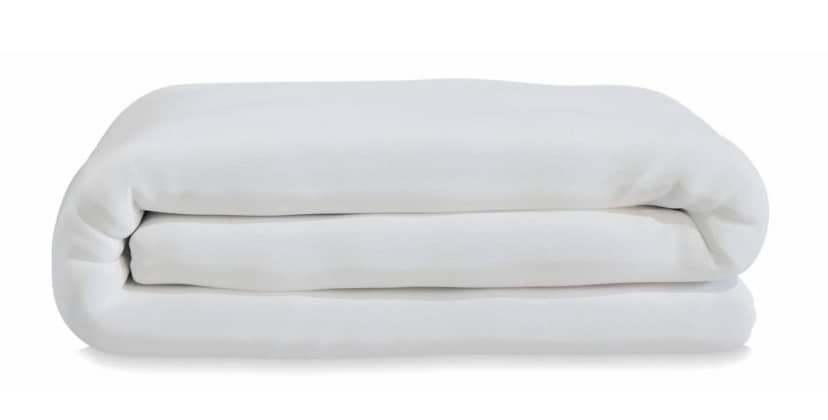When you buy through our links, we may earn a commission. Products or services may be offered by an affiliated entity. Learn more.
Best Bed Bug Mattress Covers
Bed bugs are parasitic insects that can spread quickly between people through items such as clothing, luggage, or hotel bedding. Taking steps to prevent bed bugs may help you avoid the difficult and time-consuming task of eliminating an infestation in your home.
One way to keep bed bugs from invading your sleep area is to invest in a mattress encasement. Mattress encasements are typically waterproof, and they zip around your mattress to offer protection against spills, bodily fluids, allergens, and pests. They are designed to trap and kill existing bed bugs, while preventing new ones from crawling into your mattress.
Finding an effective and comfortable mattress encasement can be a challenging task. We’ll outline the top factors to consider when purchasing a bed bug mattress encasement, including some tips for identifying and preventing an infestation. We’ll also examine the materials, performance, and pricing of some of the best bed bug mattress covers available today.
Best Bed Bug Mattress Covers
-

Best Overall
Brooklyn Bedding Mattress Encasement
Shop Now
-
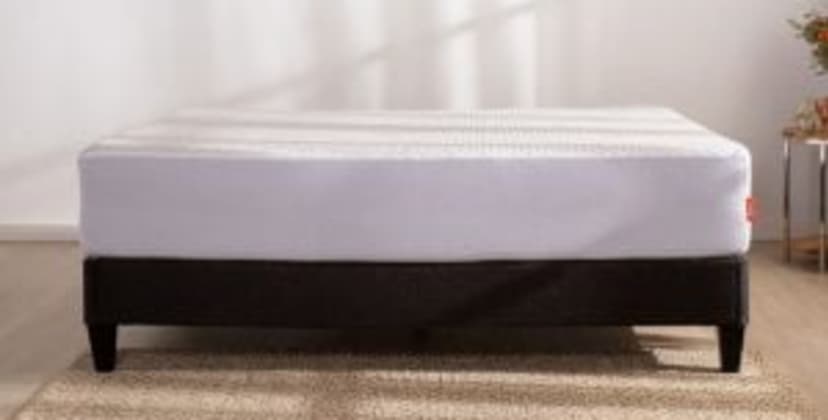
Best Value
Layla Full Encasement Mattress Protector
Shop Now
-
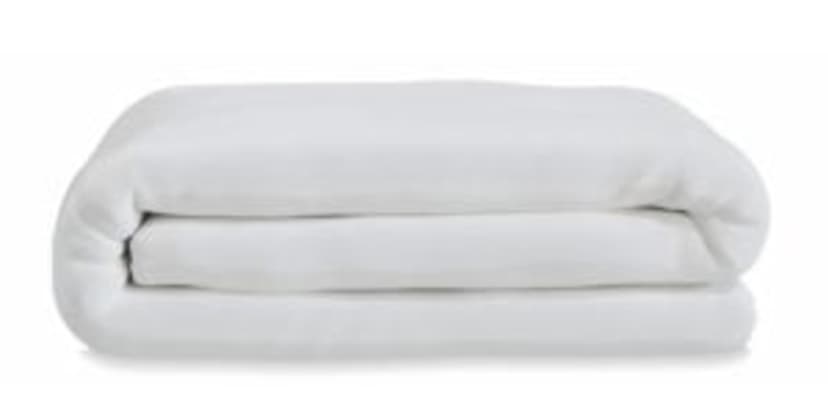
Best Cooling
Bear Encasement
Shop Now
-
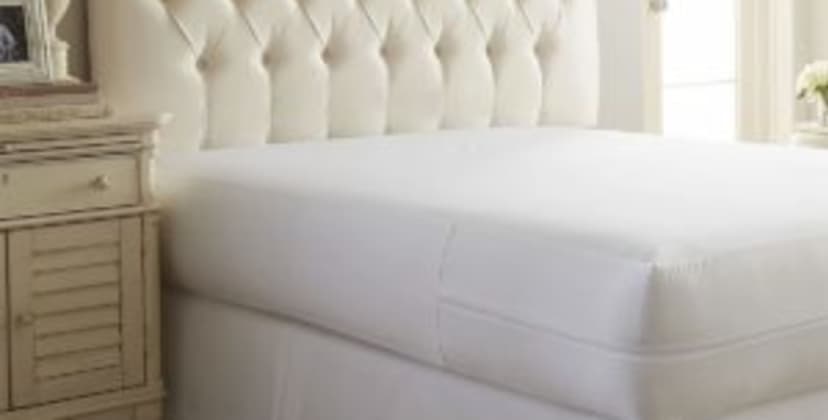
Best Deep-Pocket
Linens & Hutch 6-Sided Mattress Encasement
Shop Now
-

Best for Crib Mattresses
The Company Store Waterproof Crib Mattress Protector
Shop Now
In-Depth Reviews
Best Overall
Brooklyn Bedding Mattress Encasement
Use this link for the most current Brooklyn Bedding discounts
Shop Now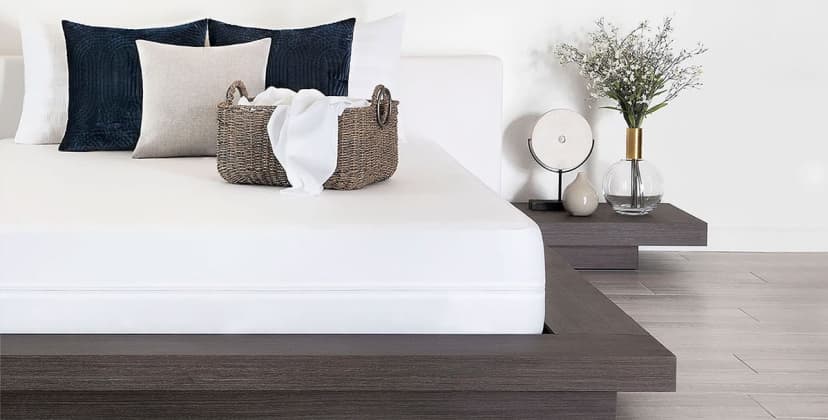
-
Who it’s best for
-
Sleepers who want a soft surface
-
Individuals with a mattress up to 13 inches tall
-
Hot sleepers
-
-
Highlights
-
Smooth top weave designed for breathability
-
Backed by a 3-year limited warranty
-
Designed to resist shrinking
-
Price
$99
Material
Polyester
Brooklyn Bedding offers a zippered polyester encasement designed to provide ample protection while remaining soft and comfortable. The Brooklyn Bedding Mattress Encasement is water-resistant and designed to keep out liquids and allergens as well as bed bugs.
While many mattress protectors are known to trap heat and moisture, the Brooklyn Bedding Mattress Encasement uses a smooth top weave to promote airflow. The white mattress encasement is available in all six standard sizes, and it is designed to accommodate mattresses with a profile of up to 13 inches. The encasement can also be machine washed in cool water and dried on low heat. The 100% polyester fabric is designed to resist shrinking.
Brooklyn Bedding provides free shipping to the contiguous U.S. The mattress encasement comes with a 30-night sleep trial and is backed by a 3-year limited warranty.
Best Value
Layla Full Encasement Mattress Protector
Use this link for the most current Layla discounts
Shop Now
-
Who it’s best for
-
Individuals looking for protection against dust mites
-
Sleepers who prefer a soft and stretchy fabric
-
People who are easily awoken by sound
-
-
Highlights
-
Stretchy, stain-resistant fabric
-
Dust mite barrier for added protection
-
Quiet construction
-
Price
$134
Material
Polyester and waterproof polyurethane membrane
The Layla Full Encasement Mattress Protector is an affordable model made using 140 gsm polyester and a waterproof polyurethane membrane. The material is stain-resistant and designed to protect against bed bugs, dust mites, liquids, and other substances.
Despite the high level of protection, the polyester fabric is stretchy, breathable, and designed to make minimal noise. The Layla Full Encasement Mattress Protector can fit mattresses with a profile of up to 14 inches, and it is available in all six standard mattress sizes.
The Layla Full Encasement Mattress Protector can be machine washed and dried.The top and bottom half are connected by a zipper, allowing users to wash only the top half if they desire.
Layla offers free shipping to addresses in the contiguous U.S. The Full Encasement Mattress Protector is backed by a 30-night trial and a 1-year limited warranty.
-
Who it’s best for
-
Those who normally sleep hot on mattress encasements
-
People who want to protect their mattress from bed bugs and liquid damage
-
Anyone who owns a mattress between 10 and 15 inches thick
-
-
Highlights
-
Liquid-proof barrier protects the mattress from spillage without sleeping overly hot
-
Stretch jersey fabric has a soft, breathable feel
-
Easily removable thanks to wraparound zipper and fully machine-washable
-
Price
$125
Material
100% Knit Polyester
If you reside or are planning to reside in a dorm room, a bed bug cover can be a smart investment — even if the facilities seem clean and hygienic at first glance. The Bear Encasement is a low-cost cover equipped with a liquid-proof barrier to protect your mattress from spills and stains as well as bed bug contamination. A soft stretch-jersey composition also ensures little interference while the encasement is in place and extra breathability on hot or humid nights.
The encasement is designed for a pocket depth of 10 to 15 inches thick, a range that should cover most dorm mattresses including bunk-friendly models. A wraparound zipper allows you to easily install the cover, and remove it whenever a cleaning is needed. To launder the encasement, machine wash in cold water on a gentle cycle, then tumble dry on low heat. You can clean the encasement with other sheets and linens to save quarters at the laundromat. Six sizes are available, all of which correspond to standard mattress dimensions.
In addition to affordable pricing, the Bear Encasement qualifies for free ground delivery throughout the contiguous U.S. Returns are allowed within 30 nights from the date of receipt. If you decide to keep the encasement, it’s also covered by a 10-year warranty against material defects.
Best Deep-Pocket
Linens & Hutch 6-Sided Mattress Encasement
60% off select products with code: SLEEP60
Shop Now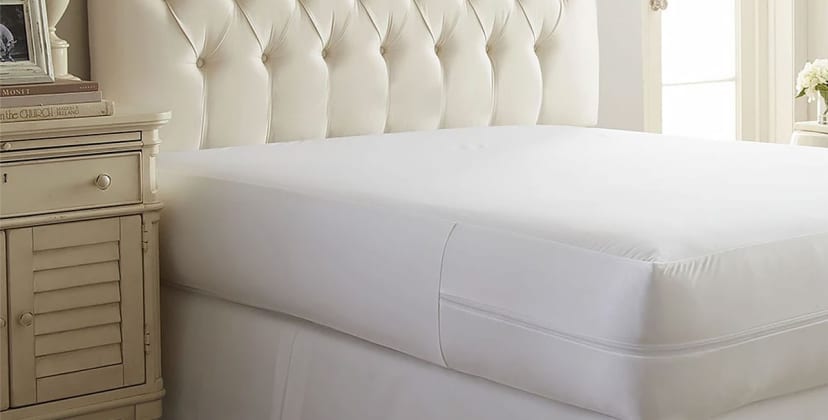
-
Who it’s best for
-
Sleepers who run warm
-
Those who are sensitive to sound
-
Individuals with tall mattresses
-
-
Highlights
-
Accommodates mattresses up to 18 inches tall
-
Top layer of microfiber for added softness
-
Stretchy fabric designed to minimize noise potential
-
Price
$96
Material
Polyester, Waterproof Polyurethane Membrane
Built of polyester and lined with a polyurethane membrane, the Linens & Hutch 6-Sided Mattress Encasement is designed to provide protection against bed bugs and other contaminants. The encasement is designed to fit mattresses up to 18 inches tall, accommodating most models on the market today. If you own a high-profile pillow-top or a thick topper, we recommend this pick.
The encasement has a soft microfiber outer cover with a weight of 95 grams per square meter (gsm), engineered to wick moisture and transfer heat away from the body. The stretchy fabric is also virtually silent, making it a suitable choice for sleepers who are sensitive to noise. The micro zipper lines all edges of the encasement so that users can easily remove the cover for washing. The encasement is resistant to fading and wrinkling, and it can be machine washed in cold water and tumble dried on low heat.
Linens & Hutch offers free shipping to addresses in the contiguous U.S., and the mattress encasement comes with a 101-night sleep trial.
Best for Crib Mattresses
The Company Store Waterproof Crib Mattress Protector
Use this link for the most current Company Store discounts
Shop Now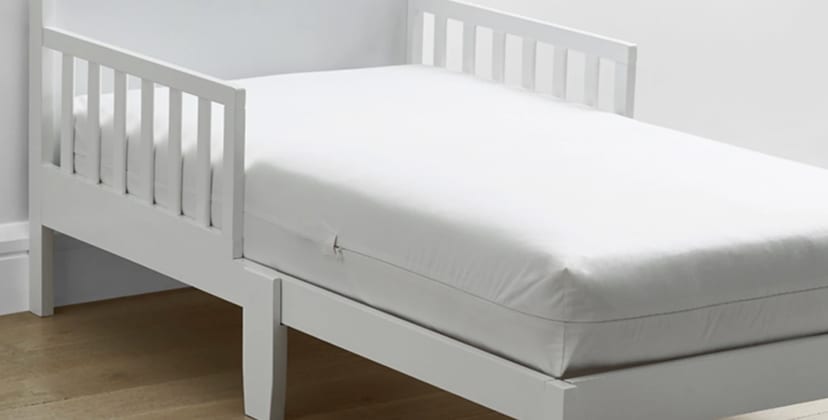
-
Who it’s best for
-
Parents who want to protect their child’s crib mattress from different types of damage
-
Babies with mattresses measuring 6 inches thick
-
Value seekers
-
-
Highlights
-
Waterproof encasement offers full protection against all liquids and contaminants
-
Outer shell composed of crisp, breathable cotton percale
-
Hidden zipper tucks behind protective flap
-
Price
$44
Material
100% cotton percale (330TC)
If you’re concerned about bed bugs and have a baby or infant at home, you can safeguard their sleep space with The Company Store’s Waterproof Crib Mattress Protector. This full encasement cover zips around the sides of your crib mattress, forming a barrier that keeps out bed bugs, dust mites, and other contaminants. A liquid-repellent barrier also prevents damage from water and nighttime accidents. The zipper tucks behind a protective flap and shouldn’t pose any hazard to your little one while they’re in their crib.
The protector is compatible with mattresses measuring 6 inches thick, which is a standard profile for crib-friendly models — though we recommend measuring yours first to ensure a proper fit. An outer shell of crisp cotton percale maintains a cool surface and prevents excessive heat retention. To clean the protector, machine-wash in warm water with mild detergent on a gentle cycle, then tumble dry on low heat. The Company Store recommends washing it prior to your first use.
The Waterproof Crib Mattress Protector carries an approachable sticker price and customers in the contiguous U.S. qualify for reasonable flat-rate shipping with their order. Returns are allowed within 30 days of the original order.
What is a Bed Bug Mattress Cover?
Sometimes referred to as a mattress encasement, a bed bug mattress cover is designed to protect against bed bugs by forming an impenetrable seal around the mattress. These covers are made of specialized fabric that zips around your entire mattress, making it more difficult for bugs to crawl inside.
Bed bug mattress encasements are one of several types of mattress covers, all of which are designed to protect the mattress in some way. Other types of mattress covers include:
- Mattress Protectors: Mattress protectors are typically designed to prevent spills, bodily fluids, dust, or other contaminants from seeping into the mattress. Protectors generally lie on the top of the mattress like a fitted sheet, and many are waterproof or water-resistant. As they leave the sides or underside of the mattress exposed, they generally do not protect against bed bugs.
- Mattress Toppers & Pads: Mattress toppers and pads are typically designed to enhance the comfort or performance of your bed by adding an additional layer of cushioning. Although not their primary function, mattress pads and toppers may also offer some protection against spills.
Standard mattress protectors, toppers, and pads are not intended for use as a barrier against bed bugs. Searching for mattress encasements rather than other types of mattress covers can help you identify options that are designed to prevent an infestation.
How to Choose a Bed Bug Mattress Cover
As with any sleep product, a mattress cover or encasement is a highly personal choice. Each individual has different needs and preferences, meaning that there is no encasement that is perfect for everyone. Learning what to look for when shopping for a bed bug mattress encasement can help you sort through all of the options available and identify the best fit for you.
What to Consider When Purchasing a Mattress Cover or Encasement
A bed bug mattress encasement can be an important purchase for hygienic reasons. This purchase may also affect your sleep quality, as some mattress encasements can trap heat or make noise when sleepers move around. Some shoppers may seek additional features such as waterproofing, easy cleaning, or extra-deep pockets for a taller mattress.
With hundreds of options to choose from, it can be overwhelming to sift through the advertising claims in the search for a quality product. We’ll outline the most important factors to consider to help you identify the best mattress encasement for you.
Price
Mattress encasements come in a wide variety of prices, though shoppers can typically expect to pay anywhere from $100 to $150 for a quality product. Factors such as fabric type, level of waterproofing, and additional features all contribute to a mattress encasement’s overall cost.
Waterproofing
Adequate waterproofing may prevent mold or stains by keeping spills, sweat, and other fluids from seeping into the mattress. Fully waterproof encasements may use liners or polyurethane membranes to completely prevent liquids from leaking through. By contrast, water-resistant encasements are designed to wick away moisture or repel water without being fully waterproof.
Bed Bug Protection Level
To provide adequate protection against bed bugs, a mattress encasement must be made of strong material that fully encloses all six sides of the mattress. Potentially vulnerable areas like zippers should carry some sort of protection to prevent bed bugs from crawling through the cracks. Look for a bed bug encasement that carries proof of having been tested in a laboratory and found to be effective against bed bugs.
Quality Materials
While quality materials may cost more initially, they can be worth the investment for hygiene and comfort. Poor-quality materials may not provide enough protection to safeguard against bed bugs, and they may be more likely to develop rips or openings that pests can crawl into. Certain materials may also be less breathable or make more noise, which can affect sleep quality.
Cooling Properties
Overheating can interrupt quality rest. Many encasements are made with waterproof materials, which can reduce breathability and trap heat close to the body. Sleepers who tend to run warm may benefit from encasements that use special materials in the cover to disperse heat and wick away moisture.
Pocket Depth
A mattress encasement that is too small may not close around your bed, while one that is too large may feel uncomfortably baggy. Shoppers with particularly high- or low-profile beds should ensure the encasement has the correct pocket depth for a snug fit around the mattress.
Cleaning
Mattress encasement models that can be removed and machine washed may be easier to care for. Some mattress encasements offer the option to remove and wash the top part of the cover only, as this is the part that comes in contact with the sleeper. Always follow the care instructions when washing the cover. Exposing the encasement to high temperatures, bleach, or fabric softeners may damage the seal.
If you are using a mattress encasement to contain an existing bed bug infestation, do not remove it for cleaning until you are sure that all the bugs are dead. Bed bugs can live up to 5 months without eating, so you may want to wait a little longer than this to be safe. To keep a clean sleep surface, you can use a regular mattress protector or fitted sheet over the bed bug encasement in the meantime.
Noise
Waterproofing materials used in mattress encasements can cause a crinkling sound, which may be bothersome to sleepers as they switch sleeping positions. Many manufacturers attempt to reduce the noise level by using special fabric blends or thinner materials. It may be useful to read through customer reviews while shopping online to determine the noise level of a mattress encasement.
How to Detect Bed Bugs
Bed bugs do not fly, but they hide in the seams of clothing, bed linens, suitcases, and other similar places, and are easily spread from place to place when people carry these items from one place to another. Hotels, dorm rooms, and other places that see a high number of transient visitors are common places to pick up bed bugs. Although traditionally associated with squalid conditions, bed bug infestations are also common in clean homes.
Identifying a bed bug infestation early can help you treat it before it becomes widespread. However, it can be challenging to recognize an infestation in the early stages. Some telltale signs to look for include:
- Reddish Stains or Dark Spots: Rust-colored stains or small, dark spots on your mattress or bed sheets may be a sign of bed bugs. These spots are often a result of bed bug excrement or crushed insects.
- Eggs and Eggshells: Bed bug eggs are tiny and can be difficult to spot, but they are a surefire way to know you have an infestation. These pale yellow eggs are typically about 1 millimeter wide.
- Nymph Skins: Young bed bugs are called nymphs, and bugs in this stage will begin to shed their yellowish skin as they grow. These skins are left behind and can be a sign of an infestation.
- Odor: Bed bugs often give off a sweet, musty odor.
- Live Bed Bugs: Bed bugs are generally about 5 to 7 millimeters large. If they have not recently fed, they have a flat, brown, oval-shaped body. Bed bugs that have recently fed have a reddish-brown tint and are shaped similar to a balloon.
Bed bugs typically reside within 8 feet of a sleep area so they can feed during the night, but they can also hide in many other areas, such as chair or sofa seams, curtain folds, drawers, electrical appliances, or loose wallpaper.
Individuals should note that bite marks alone may not be an effective way to identify an outbreak. Bed bug bites can look similar to those of mosquitoes and other pests, and some people don’t react at all to bed bugs. It is important to use other clues as well to determine if you are facing an infestation.
How to Use a Mattress Encasement to Prevent Bed Bugs
A quality mattress encasement can be an effective way to protect your mattress from bed bugs. The best bed bug mattress protectors form a seal around the mattress to prevent new bugs from making their home in your bed.
Most bed bug mattress covers are white, making it easier to spot bed bugs and take early steps to prevent a full-blown infestation. In the event that bed bugs do manage to infest other areas of the room, such as the bed frame, the encasement protects the mattress and gives the bugs one less place to hide.
Bed bug covers may also be useful if you already have bed bugs hiding in your mattress, as they prevent the bugs from crawling out and biting sleepers. Bed bugs can live for several months without feeding, but they will eventually die if they are unable to leave the mattress encasement. For this reason, experts recommend foregoing cleaning and leaving the cover tightly zipped for at least 6 months after a bed bug infestation.
Most mattress protectors and covers on the market are only designed to protect against spills or allergens, and don’t offer enough protection to keep bed bugs at bay. Standard mattress protectors and covers normally protect only the top layer of your bed and leave the sides or underside of your mattress exposed.
To be effective, a bed bug mattress encasement should zip entirely around the mattress and utilize quality, tight-knit materials that bugs cannot bite or crawl through. The zipper should be small enough not to leave gaps in the teeth or the ends when closed. Always ensure the cover is properly installed and fully zipped, and consider securing the zipper closed. Inspect the cover regularly for rips and tears that bed bugs can crawl through.
It is also important to take other steps to prevent bed bugs, as they can inhabit any area in your home, such as pillows, box springs, curtains, and furniture. Proactive habits such as washing new clothes, vacuuming luggage when returning home, and regularly checking for bed bugs can help you prevent or identify outbreaks. You may be able to buy bed bug protectors for your pillow and box spring as well. Once you have a bed bug infestation in your home, you will likely need to call a professional exterminator to eliminate the pests.
Health Risks of Bed Bugs
Bed bugs feed on blood, and their bites typically produce small red lumps that can remain itchy and bothersome for several days. Scratching these bites may leave people vulnerable to secondary infections due to broken skin. More rarely, these bites may cause allergic reactions and even anaphylaxis.
Along with physical health impacts, bed bugs can lead to mental health issues. Research suggests that people living in an infected area report higher levels of anxiety and may be more likely to suffer from insomnia, paranoia, or nightmares.
Though bed bugs have not been shown to transmit any blood-borne diseases, early evidence suggests bed bugs may contribute to the transmission of Chagas disease in areas where this disease already exists.
Contact your healthcare provider if you suspect you have been exposed to bed bugs and you are concerned about issues such as allergic reactions, infections, or mental health impacts.
Frequently Asked Questions About Bed Bug Mattress Encasements
When it is used properly, a quality bed bug mattress cover can be an effective tool to protect your mattress against bed bugs and potentially catch infestations before they grow. It is important to select an encasement that zips completely around the mattress to form a seal. While a bed bug mattress encasement is a good first step, it is also important to take steps beyond a mattress cover to adequately protect the rest of your home against bed bugs.
Although bed bugs are generally unable to chew through plastic, they can crawl through tiny openings. To be effective against bed bugs, a plastic mattress cover must zip closely around the mattress without leaving any openings or gaps that these pests can crawl through. The part of the cover most likely to have exposed gaps is usually the zipper, so it's crucial to verify whether the manufacturer has included safeguards to protect this potential opening.
It is still possible to get bed bugs with a mattress cover. Bed bugs are able to infest any area of the home, such as couches, drawer joints, loose wallpaper, or headboards. The benefit of a bed bug mattress cover is that it makes the bugs easier to spot, and it may stop bed bugs from entering or leaving your mattress. Without this protection, many sleepers find they need to discard their mattress after a bed bug infestation.
Most often, bed bugs are transported from place to place on luggage, clothing, or bedding. Bed bugs are especially common in hotels, hostels, dorm rooms, and other shared accommodation. Adopting preventative habits such as washing your clothing after traveling or vacuuming your luggage upon returning home may help reduce your chances of a bed bug infestation.
Mattress covers are placed on top of a mattress like a fitted sheet, while encasements zip around the mattress to offer complete protection. Because mattress covers are only placed on the top of the bed, they do not prevent bed bugs from crawling to the mattress.Many mattress covers are waterproof and easy to remove for simple cleaning. Mattress covers may be a good fit for individuals who primarily want protection against spills and bodily fluids.Those who are concerned about bed bugs and other pests should opt for a mattress encasement. Encasements form a seal around the full mattress, including the bottom, to provide protection around every angle of the bed.

Still have questions?
Our product experts have extensive experience testing just about every sleep product on the market.
Send an email to [email protected] with your questions and we’ll help you find exactly what you’re looking for.

